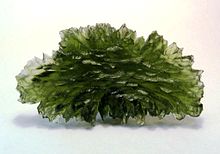- Moldavite
-
Moldavite (Czech: Vltavín) is an olive-green or dull greenish vitreous substance possibly formed by a meteorite impact. It is one kind of tektite. It was named[citation needed] by A. Dufrnoy for the town of Moldauthein (Czech: Týn nad Vltavou) in Bohemia (the Czech Republic), where it occurs. It is sometimes cut and polished as an ornamental stone under the name of pseudo-chrysolite.
Contents
Origin
Moldavite's bottle-green glass colour led to its being commonly called Bouteillen-stein, and at one time it was regarded as an artificial product, but this view is opposed to the fact that no remains of glassworks are found in the neighbourhood of its occurrence; moreover, pieces of the substance are widely distributed in Tertiary and early Pleistocene deposits in Bohemia and Moravia. For a long time, it was generally believed to be a variety of obsidian, but its difficult fusibility and its chemical composition are rather against a volcanic origin hypothesis.
F. E. Suess pointed out that the nodules or small masses of moldavite presented curious pittings and wrinkles on the surface, which could not be due to the action of water, but resembled the characteristic markings on many meteorites. Boldly attributing the material to a cosmic origin, he regarded moldavite as a special type of meteorite for which he proposed the name of tektite. To this type are also referred the so-called obsidian bombs and buttons from Australia and Tasmania, known sometimes as australites, and called by R. H. Walcott obsidianites. Similar bodies have been found in Indonesia[1] and have been termed billitonite, from the isle of Belitung where they occur in tin-bearing gravels. Usually they are flat, rounded or ellipsoidal bodies, sometimes surrounded by an equatorial girdle or rim, and often with a brilliant black superficial luster, as though varnished. Moldavite has been reported also from Scania (Sweden).
It is also widely argued that the moldavite glass was formed 15 million years ago during the impact of a giant meteorite in present-day Nördlinger Ries. Splatters of rocks that were melted by the impact cooled while they were actually airborne and most fell in central Bohemia - traversed by Vltava river (German: Moldau). As such the glass can be found in the Czech Republic, Austria and Germany.
Isotope analysis of samples of moldavite have shown a beryllium-10 isotope composition typical of the Australasian and Ivory Coast tektites.[2]
Use
The total amount of Moldavite scattered around the world is estimated at 275 tons. There are now only four[citation needed] moldavite mines that are in full operation in the Czech Republic. It is predicted that in less than ten years from now commercial Moldavite mining will come to an end. After this time, there will be virtually no appreciable amount of gem-grade Moldavite left in the ground.
The Venus of Willendorf, which some have held to be an ancient goddess statue, was discovered in a site that contained a few amulets of Moldavite.[3]
There are typically two grades of moldavite: high quality, often referred to as museum grade, and regular grade. Museum and regular grade moldavite can be told apart by the way they look: The regular grade pieces are usually darker and more saturated in their green colour, and the surface is seen as closely spaced pitting or weathering. This type sometimes appears to have been broken apart from a larger chunk.
The museum grade has a distinct fern-like pattern and is much more translucent than the regular grade. There is usually a fairly big difference in the price between the two. The museum grade "flower bursts" are much more prized by the connoisseur. High-quality moldavite stones are often used in hand-crafted jewellery and thus enter the market away from mainstream jewellery fashions, more centred around art and craft, and as such have gained an almost cult status.
Moldavite occurrences are reported mainly from Bohemia and Moravia (Czech Republic), with occasional finds in Waldviertel (Austria) and Lusatia (Germany).
References
- ^ [1] www.tektites.co.uk
- ^ Serefiddin, 2006
- ^ Simmons, Robert (2005, 2007). The Book of Stones: Who They Are & What They Teach. Heaven & Earth Publishing. Source: [2] (accessed: Tuesday April 13, 2010)
External sources
- M. Trnka – S. Houzar: Moldavites: a review PDF . Bulletin of the Czech Geological Survey, Vol. 77, No. 4, 283–302, 2002 Czech Geological Survey, ISSN 1210-3527
- J. Baier: Zur Herkunft und Bedeutung der Ries-Auswurfprodukte für den Impakt-Mechanismus. - Jber. Mitt. oberrhein. geol. Ver., N. F. 91, 9-29, 2009.
- J. Baier: Die Auswurfprodukte des Ries-Impakts, Deutschland, in Documenta Naturae, Vol. 162, München, 2007. ISBN 978-3-86544-162-1
- F. Serefiddin, et al., Terrestrial Cosmic-Ray Exposure History of a 23-gram Moldavite and Evidence for the Presence of Meteoric Beryllium-10, Lunar and Planetary Science XXXVII (2006) PDF
- Mindat with location data
 This article incorporates text from a publication now in the public domain: Chisholm, Hugh, ed (1911). Encyclopædia Britannica (11th ed.). Cambridge University Press.Categories:
This article incorporates text from a publication now in the public domain: Chisholm, Hugh, ed (1911). Encyclopædia Britannica (11th ed.). Cambridge University Press.Categories:- Gemstones
- Glass in nature
- Impact event minerals
Wikimedia Foundation. 2010.



